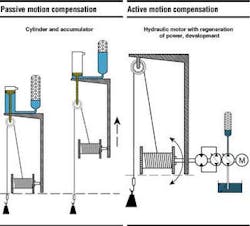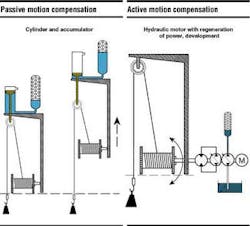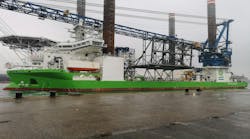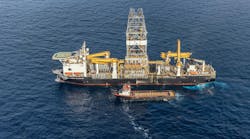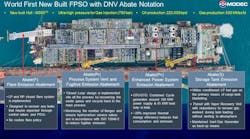Lidan Marine has been providing marine winches of all sizes and capabilities to the marine market for over 90 years. It supplies high pressure hydraulic winches for oil and gas drilling and production vessels, diving support and anchor handling vessels.
In the past few years, the company has developed a series of heave compensating winches with active hydraulic compensation. Active motion compensation uses a hydraulic cylinder and accumulator as a 'spring' to maintain a steady tension on the cable being paid-out from the winch drum and towed by the vessel.
Several different compensation systems are available, depending on the application. The advantages of these systems are low power consumption, good regulation with small faults, and adapted regulation parameters for the compensation task. Ship motion is sensed by way of an accelerometer. There are five basic types of motion compensation available: two passive motion systems and three active compensation types.
Passive systems
The most basic type of motion compensation is passive using a simple cylinder and accumulator system. A plunger is attached to the main pulley and pushes oil from the cylinder into the accumulator as the vessel rises and falls with the sea swells. This style is best for high resistance equipment such as diving bells. There is no power consumption in this passive system.
Passive motion compensation using a hydraulic motor for constant tension is similar, except that the motor is constantly active and uses full power. The system must be adjusted for the load, but the system is easy to understand and maintain. This system is also best for in-water equipment with a high resistance to motion.
Active systems
Active motion compensation using a cylinder and accumulator requires an additional smaller cylinder above the passive motion compensation system. An accelerometer senses the ship motion and the small cylinder then responds to actively position load-out from the ship's movement. The system has low power consumption, but must be adjusted for the actual load on the line. The extra space required for the extra cylinder is small.
Active motion compensation using a hydraulic motor is accomplished by constantly running the motor, but moderating the force applied to the load. Although the motor is constantly running, it can adapt to the actual load and is not limited to the piston heave length in the passive cylinder and accumulator system. This adds important flexibility for vessels that have multiple missions or operate towed equipment in many different oceans or sea states.
The active motion compensation system can be further regulated by the addition of a smaller accumulator for power regeneration. The accumulator 'recycles' hydraulic energy to reduce power consumption by the motor and adds flexibility to the motion compensation system.
The company recently developed a new winch system for the Swedish Navy for towing sonar equipment. The boom-bobbing jib system saves 60-70% of the energy needed for a traditional winch system due to the hydraulic accumulator that dampens wave action to keep the towed load in position. To date, six units are in service, with two more on order.
The system will be used on the Navy's stealth corvette and will control an A-frame jib from which the sonar 'fish' is launched and recovered. This work opens new markets in towed sonar systems and streamer compensators for seismic vessels.
The towed array accumulator system (TAAS) is 50% lighter than the standard winch and further weight reductions are possible. The cable is easy to change and the winch is computer controlled. It uses a lightweight Hagglunds hydraulic drive with the level wind cable guidance system for easy spooling of the cable.
For more information, contact Mats Pålsson, Lidan Marine. Tel: +46 (0)510 684 81, Fax: +46 (0)510 684 88 40, E-mail: [email protected].
